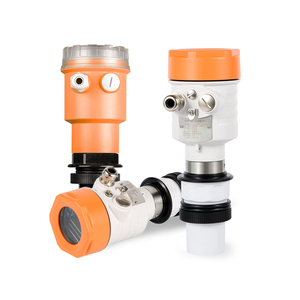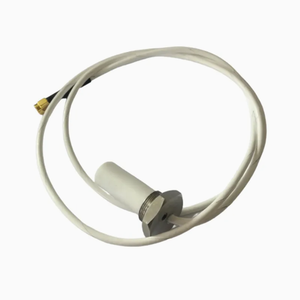
All categories
Featured selections
Trade Assurance
Buyer Central
Help Center
Get the app
Become a supplier

(927 products available)



















































The adhesive ultrasonic level sensor is a type of non-contact sensor that measures level by emitting ultrasonic sound waves through a liquid or solid surface, returning to the sensor to measure distance. Several variations are based on how they are integrated into systems, operational principles, and measurement mediums. Here are the most common ones:
Ultrasonic Adhesive Level Sensors
These sensors use an adhesive bonding method for mounting, allowing for a robust and sealed installation in various applications. The ultrasonic waves are transmitted into the medium, reflecting off the surface, and measuring the distance to calculate the level. This option is particularly useful when sealing against contamination or moisture is necessary.
Non-contact Ultrasonic Level Gauges
These gauges measure level without touching the substance through sound waves. This method is suitable for measuring the level of chemicals, oils, and water, where cross-contamination must be avoided. It is a perfect choice for sensitive materials since it maintains their purity and integrity.
Continuous Level Sensors
Adhesive ultrasonic continuous level sensors provide real-time monitoring by continuously measuring the distance from the sensor to the material's surface. This type is important for processes that need constant feedback, such as in chemical manufacturing. With a continuous flow of data, operational adjustments can be made immediately for improved process control.
Displacement Ultrasonic Sensors
These sensors are particularly used to measure changes in level by detecting variations in the ultrasonic waves, focusing on the precise measurement of the distance between the sensor and the surface. In industries such as oil and gas, these sensors find their application in tank level measurement, where even minor level changes need to be monitored.
Point Level Sensors
Point adhesive ultrasonic level sensors detect high or low alarm conditions. They are commonly used in two applications: filling and emptying where safe levels must be monitored. These sensors can be installed easily and provide a reliable solution for preventing overflows or triggering low product alerts.
The ultrasonic level gauge comes in a great variety of materials and durability characteristics depending on the target application environment. Some of the most popular and commonly used materials are as discussed below:
Special Materials
The sensing element or transducer of ultrasonic sensors can be made from special materials like piezoelectric ceramics or polymers, which convert electrical energy into ultrasonic waves. There can be an occurrence of variation in performance and temperature with these materials. For example, with ceramic transducers, they can have a special process whereby they are made sensitive to a very wide temperature range.
Housing Materials
Usually, the housings for adhesive ultrasonic level sensors are made from durable plastics such as polycarbonate or ABS, and in some cases metals like stainless steel. The choice of material is greatly affected by the environment in which the sensor is to be placed. For example, stainless steel is frequently used in the food processing industry due to its resistance to corrosion and adherence to hygiene standards.
Signal Processing Circuits
The internal components, such as the signal processing circuits of an adhesive ultrasonic level sensor, can be determined by the durability of common electronic materials, including copper and silicon. Proper encapsulation is important to protect these components against moisture, dust, and other contaminants. The monitoring of level in critical applications, like hazardous liquids or slurries, is ensured due to good-quality circuit materials.
Environmental Protection Covers
Environmental protection covers are made out of rubber or silicone, which are used to cover ultrasonic sensors and protect them from exposure to harsh chemicals, extreme temperatures, and mechanical shocks. These materials, when applied to the sensor, enhance its durability significantly. Silicone, for instance, maintains flexibility over a large temperature range, while rubber can effectively dampen vibrational effects.
Adhesive Bonding Areas
In ultrasonic level sensors, the adhesive bond areas are frequently constructed using robust materials like epoxy resins or specially formulated adhesives for effective bonding. These materials allow the sensor to be securely integrated into the monitoring system, providing increased durability, especially in environments where traditional mounting methods may fail. Epoxy resins exhibit high resistance to most environmental factors, including humidity and chemicals.
Chemical Industry
Adhesive ultrasonic level sensors are applied in the chemical industry to measure the level of liquids in storage tanks. The principle of non-contact measurement is particularly useful when dealing with corrosive substances that might damage direct-contact sensors. These sensors help ensure that optimum chemical levels are maintained, preventing overflows or shortages, thus improving on safety and efficiency in chemical processes.
Water and Wastewater Treatment
Level measurement is important in any water and wastewater treatment process, and adhesive ultrasonic level sensors assist in this task. They are used in reservoirs, ponds, and pumping stations to maintain optimal water levels and control the flow. These sensors also help monitor hazardous materials, helping to avoid exposure to personnel. Their precision and dependability are crucial to the effectiveness of the treatment operations.
Oil and Gas Industry
In the oil and gas industry, adhesive ultrasonic level sensors are commonly used in tank measurement and inventory control. These sensors enable a safe and effective way of measuring levels in a variety of hazardous substances, like crude oil and petroleum products. The non-contact method helps avoid any possible interference with the processes and enhances operational safety by providing accurate measurements.
Food and Beverage Industry
Sensors are critical in food and beverage industries to ensure the levels in various liquids, like sauces and beverages, are monitored. Adhesive ultrasonic level sensors are the preferred choice here, as they ensure no contact with the contents happens, so the product quality is maintained. These sensors are also used in controlling the levels of ingredients and liquids, promoting system efficiency and hygiene.
Inventory Management in Warehouses
Adhesive ultrasonic level sensors can also be used to measure the level of bulk materials in silos and warehouses, providing data for efficient inventory management. They enable the measurement of different materials, such as grains, powders, and building materials, ensuring accurate stock levels are maintained. Such application of these sensors leads to optimization in ordering processes, minimization of stockouts, and reduction of excess inventory.
Selecting the right adhesive ultrasonic level sensor for a given application needs careful consideration of several factors. Here are the factors that one needs to consider:
Measuring Range
The measuring range is the distance over which the sensor can accurately measure level and should match the expected range of liquid or material in the container. Selecting a sensor with the appropriate range limits means that measurement will be accurate throughout the process, avoiding under-ranging or over-ranging situations that can make the readings erroneous.
Process Conditions
When selecting a sensor, one must consider temperature, pressure, and the nature of the measured material, as these will affect its performance. Make sure the sensor withstands any of these conditions without incurring damage. It is important to ensure the sensor selected has the necessary durability and can operate effectively without losing accuracy.
Tank Geometry and Surface Conditions
The geometry of the tank or container can also have an effect on the level measurement, especially if there are baffles or agitators inside. In cases where turbulence might occur, choosing a sensor with a proper beam angle will help avoid false readings. Additionally, the surface condition of the material, whether it is calm or has ripples, will require a different focusing of the ultrasonic beam.
Sound Speed Damping
Damping of the sound speed by the material being measured will affect the accuracy of the measurement, with some brands having built-in compensation. For materials like slurries or solids that reflect the sound waves too strongly, look for a sensor that helps offset such effects. Choosing a sensor with adequate internal compensation is critical to maintaining measurement accuracy in those applications.
Installation Requirements
Depending on the kind of installation required, one can choose an installation-friendly model or a more complex one. Consider how easy it will be to mount the sensor and whether room is available for its installation. It is also necessary to consider the available power and communication facilities, especially if they need to be integrated with the existing equipment.
Application-Specific Features
Some applications might call for specific features, such as the sensor's ability to correct for foam or vapors. For example, some sensors have algorithms that compensate for foam, vapors, or mists that might absorb or scatter the ultrasonic waves. These application-specific enhancements will help improve the sensor's performance in that particular environment.
Yes, adhesive ultrasonic level sensors can measure the level of solid materials, especially in bulk form, like powders, granules, and some types of solids.
These sensors can operate in high-temperature environments, provided that the materials used in the sensor construction are such that they can withstand the temperatures.
The sensors are generally able to perform well, but extreme turbulence may cause reverberations that affect measurement accuracy.
Yes, the sensors can be used outdoors, but they must be protected from environmental factors like rain, dust, and extreme temperatures.
Capacitive sensors would measure level based on the change of capacitance caused by the material being measured, while ultrasonic sensors would use sound waves. Ultrasonic sensors would perform better for non-conductive and non-viscous liquids, while the capacitive sensors would measure the level of all liquid levels irrespective of its nature.